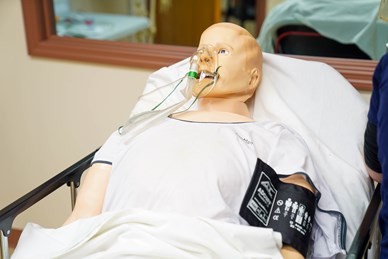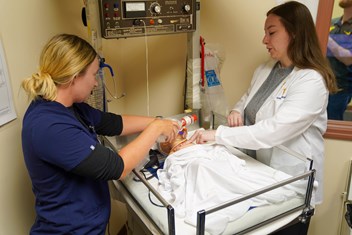- Positions
- Assistant Program Director, WVU Rural Family Medicine Residency Program, Department of Family Medicine - Eastern Division
- Medical Director, Simulation Lab, Eastern Division
- Phone
- 304-535-6343
Simulation Lab
Providing students with an authentic and controlled learning environment
The simulation lab, located at the Health Sciences Center Eastern Division on the WVU School of Medicine’s Eastern Campus, offers medical students the opportunity to receive valuable hands-on training experiences while maintaining a controlled environment specialized for medical education.
The lab is led by simulation director Aaron McLaughlin M.D., and is assisted by simulations specialist Charles Morris, AAS, BSN. Dr. McLaughlin hosts weekly simulation sessions for third- and fourth-year medical students on Friday afternoons. Typically, these sessions are arranged to coincide with the participating students’ ongoing clerkships. Other simulation sessions are held periodically as scheduled and are led by School of Medicine faculty.
Specialized exam rooms for delivering unique training experiences
The simulation lab offers a variety of training experiences for students, utilizing state-of-the-art simulation technology in two distinct clinical settings. The lab consists of the following:
- Fully-equipped primary exam room
- Fully-equipped obstetrics and gynecology-focused exam room
- Control room to manually operate simulation manikins
- SimMan patient simulation manikin
- VICTORIA patient simulation manikin
- Infant patient simulation manikin
- Neonatal training station
The lab consists of two exam rooms, each of which are designed to offer students with unique training experiences in a specialized environment.
Hands-on training across several medical disciplines
 The primary exam room provides a broad, hospital-centric training environment. Here, students can perform simulations in several areas of medicine including family medicine, pediatrics and emergency medicine.
The primary exam room provides a broad, hospital-centric training environment. Here, students can perform simulations in several areas of medicine including family medicine, pediatrics and emergency medicine.
This room utilizes SimMan, a patient simulation manikin that can display neurological and physiological symptoms to simulate a variety of medical scenarios. SimMan can be used to simulate cardiac conditions, breathing complications, seizures and various other conditions commonly observed by medical students and residents.
Offering a unique focus on obstetrical care

The second exam room offers a specialized obstetrics and gynecology-focused learning environment. In this space, students can simulate performing infant deliveries by utilizing VICTORIA, a state-of-the-art manikin that can simulate a full range of obstetrical events. Students can simulate scenarios such as pregnancy complications, high-risk deliveries, postpartum emergencies and non-gravid scenarios for general nursing care.
The OBGYN exam room also offers a neonatal training station for students. Upon delivering an infant simulation manikin from VICTORIA, students can transport the infant to the neonatal station. There, they can check the infant manikin’s vitals and perform health assessments to determine if additional care is needed.
- Position
- Simulations Specialist, Eastern Division

